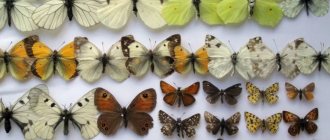Many people suffer from collecting insects in childhood. Not everyone succeeds: some become entomologists and do this for the rest of their lives. A collection of insects, even collected by an amateur, can have scientific value. But to do this, when collecting it, you need to follow some rules.
Peter Petrov
Laboratory assistant at the Department of Entomology, Moscow State University. M.V. Lomonosov, a specialist in swimming beetles. For many years he has been conducting summer field practice in entomology for students in the bioclass of Moscow Gymnasium No. 1543. He has translated 12 popular science books into Russian, including a collection of essays by Richard Dawkins “The Devil’s Chaplain.”
There are a lot of insects in the world, more than a million species, so to study them it is useful to focus on one group. For example, on beetles (many professional entomologists specialize in only one family from the order of beetles - such a large order). Or on bedbugs. Or butterflies... Although collecting butterflies is a special art.
To seriously study insects, unfortunately, they have to be killed. But let us remember that every time we run on the grass, we crush them in abundance. That is, killing a few insects for the sake of studying them is no more reprehensible than running across the lawn.
Who collects such collections and why?
First, let's figure out what a butterfly collector is called. Everything here is quite simple, although it is difficult to pronounce this term - lepidopterophilist. So, if you want to seriously engage in such a hobby, you will have to practice in order to pronounce your new status without hesitation.
It is also clear why a butterfly collector is engaged in this business. Still, not many representatives of the fauna on the planet can boast of such diversity and beauty as these insects. True, their beauty is short-lived - some butterflies live only a few days, or even hours. There are breeds that don’t even have a mouth, since they never have to eat once in their entire lives. But under glass, these fluttering flowers can be preserved for many years and even decades. In addition, this is a great way to learn more about wildlife. Therefore, this hobby can be recommended to both adults and children. Of course, there is a lot to know before you do it.
What is the name of the collection of dried insects and butterflies?
Collection of dried insects, butterflies
A collection of dried insects is called an entomological collection. It should be noted that specimens are pinned with a special pin and selected for certain distinctive features. They are stored in special boxes. Collecting butterflies is called lepidopterophilia.
Do not under any circumstances call an entomological collection a herbarium, since this concept applies only to plants.
Why is it so important to involve children in collecting herbariums?
The school curriculum for such general education subjects as biology, natural history, and natural history necessarily includes the topic of the herbarium. As homework, the teacher often asks students to collect a herbarium and make interesting crafts from a herbarium made up of plants from their area or some specific plants.
Translated from Latin, herbarium means “grass.” It is a collection of plants dried according to the rules.
To do this work correctly, you need to study the following points in detail:
- how to collect a herbarium,
- what are the features of the subsequent design of such a collection,
- how you can creatively modify the collection,
- how to preserve your herbarium for a long time so that memories from childhood remain.
The herbarium can contain either a single flower or branch or a whole plant.
The answers to all the above questions are described below.
How to catch insects for collection: recommendations
Catching insects for collection
Collecting an entomological collection is possible only for the purpose of expanding the knowledge of young naturalists. As for chasing insects for fun, this is strictly prohibited. In general, children collect butterflies, beetles and other common insects that can be encountered during walks. How to catch insects for collection?
Here are important nuances and recommendations for a young or adult collector:
- You should not dress in the latest fashion - clothes should be simple and comfortable.
- Particular attention should be paid to shoes. Ideally, it should protect your feet from cold and dampness. Wear resistance is also important.
- The headgear should not distract from fishing or fall off during a fast run. It is inconvenient to hold it with your hands.
It is important to know the time:
- It is better to catch insects in May and June.
- However, there are some species that are found towards the end of summer.
- It is best to choose the afternoon hours, since most insects fly in the hottest time, after lunch.
Let's say moths hide when the sun goes down. If the insects are nocturnal, of course, they are caught after sunset. It is very easy to catch insects before a thunderstorm. The air is stuffy, and the stuffiness forces them to leave their shelters.
The better way to catch butterflies and other beetles, mosquitoes, moths and so on:
- As a rule, naturalists use special nets.
- A stick serves as support.
- This net is a strong wire circle with a diameter of about 30 cm . Attached to it is a cone-shaped bag made of lightweight fabric.
How to catch an insect:
- You should approach carefully.
- The shadow should be behind the insect, and not in front - otherwise it will slip away.
- The net should be cast quickly and accurately, surrounding the insect and preventing it from escaping.
- In addition to the mesh, there must be scissors made of strong iron wire.
Where are butterflies, beetles, moths, mosquitoes and other “bugs” with wings found:
- Often these are fields, the edge of a forest with flowers, meadows, etc.
- Moths can be caught as dusk approaches. Then there are swarms of small midges.
- You can attract butterflies by watering the branches of a tree with a mixture of honey, water and white beer or sugar water.
They should gather on one of the branches and this will make it easier to catch them. Watch a video of how Canadian scientists catch insects using convenient and interesting methods:
Now, even in the farthest corner of Russia, every owner of a hedgehog, and not only hedgehogs, can pamper their pet with healthy natural treats. We offer dried and canned insects with delivery to any region.
When buying a hedgehog, you must understand that this is an exotic pet that requires appropriate nutrition. No matter how expensive dry food is, a hedgehog cannot live without insects.
Our food is suitable not only for hedgehogs, but also for meerkats, toothfish, sugar gliders, turtles, small rodents, hamsters, rats, monkeys, birds, and other insectivorous animals.
Insects are very rich in proteins, which are almost impossible to replace.
Canned insects are no worse than frozen ones. They are rolled into a jar in their original form (whole), retain their freshness and integrity, which means they are perfectly eaten. During preservation, a special temperature regime is used; due to a certain processing technique, the hard parts of an insect, for example a two-spotted cricket, can be significantly softened, which means making the process of consumption much more convenient for the pet. It is especially worth noting that all the nutritional value and usefulness of the product is preserved. Canned insects are not only a healthy delicacy, but also rich in vitamins and microelements, and also have high nutritional value.
What about dried insects ? I am often asked whether they are so useful and whether they are worth buying at all. The difference is the same as between fresh and dried fruit. For example, fresh grapes and dried raisins.
Each insect is selected according to the size and integrity of the individual, dried at a certain temperature, which allows you to preserve both the integrity of the product and most of the vitamins.
The dried and canned insects offered by our nursery have high nutritional value, excellent taste (tested by my hedgehogs), and will serve as an indispensable additional high-quality and healthy food for your animal.
Our range of canned insects includes: mealworm larvae, two-spotted cricket and a mixture of insects. Dried insects : grasshopper, shrimp, mealworm, dried zoophobass, American cockroach, silkworm, insect mixture.
Sealed packaging allows you to transport such insects to the farthest corners of the Russian Federation, and storage will not create problems - a dry and dark place is ideal for storage.
If you are leaving somewhere, and the person to whom you have entrusted to look after your pet for some reason does not want to be associated with live or frozen insects, canned and dry insects are the ideal way out of the situation. After all, you need to pamper your pet with a tasty treat.
If you are afraid. that during delivery the jar will break, and the bag of dried insects will simply turn into garbage, I hasten to reassure you. Each package of insects is wrapped in individual bubble wrap. If insects are ordered with a running wheel or other product, then the insects are placed in a separate small box, thus creating a double secure package that protects each package or jar from deformation.
I have been sending wheels and accessories for several years now, and insects for several months now. In my experience there were no lost or deformed parcels.
We pay special attention to the speed of shipments. As a rule, the parcel is sent on the day of payment, but no longer than within 24 hours (provided that it is not a weekend). After sending, each client is sent a photo of the receipt confirming the shipment of his particular parcel.
Having paid for the goods, you will not have to wait long for the shipment, and then also for a photo of the receipt. Efficiency and an individual approach to each client are the main principles of our work. We hope that our clients appreciate this, so they come back to us again.
Sincerely,
nursery "African hedgehog"
How to kill insects for an entomological collection?
Insects in the entomological collection
This must be done quickly and humanely. You shouldn’t let a living creature suffer for a long time. This develops cruelty in children. Little butterflies just get squeezed. Larger insects can be doused with hot water. Or put sulfuric ether at the bottom of the box.
About punctures:
- The puncture with a pin is carried out in the middle of the chest.
- You need to carefully pass the pin through the entire body.
- The insect should be spread out on a damp board. It should dry.
- Each board should be equipped with a piece of paper glued with gum arabic. This makes it easier to determine what species or type the insects belong to.
- They should be stored in boxes with cork or peat at the bottom.
- It is best to prick butterflies from top to bottom.
- Before the box is closed, a bottle of gasoline is dropped into it. It protects against moths and bugs.
- If the butterfly has wrinkled over time, it should be placed under a glass cover and then straightened.
Worth knowing: If mold appears on a bug, then lubricate this area with a brush with alcohol or ether.
Here's more information on how to kill insects for an entomological collection:
- Collectors should remember that killing insects is, in this case, a necessary necessity, and not a way of obtaining pleasure.
- As a rule, specially made stains are used. This is the most painless way to take the life of an insect.
- They can be with sulfuric or acetic ether, or chloroform.
You can make stains using tall glasses made of thick glass or jars. It’s great if you can seal the stain with a cork stopper.
Tip: Place some tissue paper at the bottom of such a glass or jar. This is especially necessary if you want to dry several insects at the same time. This method helps to prevent insects from rubbing and forming a ball. Butterfly stain does not require paper.
It's also worth remembering:
- There should be several stains. Large beetles should not be placed in the same container as flies, etc.
- In order to kill insects, you need to wet the cotton wool with the above mentioned agents. Vapors from various ethers and alcohols can kill living organisms.
- Acetic ester kills more slowly. However, insects killed in this way are softer.
- If there is no ether or chloroform, you can use gasoline.
Precautionary measures: Ether and gasoline are flammable substances. Therefore, when using them to treat insects, be careful.
HIGH TEMPERATURE to kill insects. This method is suitable if you do not have poisons or do not want to use them. To do this, do the following:
- Take a tin or zinc jar.
- Close the lid tightly.
- Place in boiling water.
Don't do this to insects that have developed jaws. They can ruin other copies.
Killing can be carried out in wine alcohol:
- Dip the insects into a container with this substance and you’re done.
- But it is important to remember that this is suitable for those who do not have long, bright hairs or scales.
- That is, you can only kill dark-colored beetles this way. The alcohol strength must be at least 60°.
As you can see, each type of beetles, butterflies, moths, mosquitoes and other insects has its own method of killing.
Important Details
To prevent insects from molding in the boxes, freshly chopped ones should be allowed to dry without closing the lid tightly. If the room is dry, they will dry in a week or two. Then it is better, on the contrary, to store them in tightly closed boxes so that they are not eaten by other insects, such as carpet beetles, many of which feed on dry corpses, including those stored in collections.
A novice entomologist should get acquainted with specialists and seek their advice. In Moscow, such people can be found, for example, at the Department of Entomology of Moscow State University, where a school club operates. In St. Petersburg there is the Zoological Institute of the Russian Academy of Sciences, where many entomologists work and one of the best entomological collections in the world is stored. By the way, the employees of this institute maintain a rich website about beetles (https://www.zin.ru/animalia/coleoptera/), on which they willingly post not only scientific works, but also many other materials and images, including those sent from all over light by bug lovers. In Yekaterinburg, insects are studied at the Institute of Plant and Animal Ecology of the Ural Branch of the Russian Academy of Sciences, in Novosibirsk - at the Institute of Systematics and Animal Ecology of the Siberian Branch of the Russian Academy of Sciences, in Vladivostok - at the Biology and Soil Institute of the Far Eastern Branch of the Russian Academy of Sciences.
Published in the magazine “Schrodinger’s Cat” No. 6 (08) for June 2015.
How to painlessly euthanize an insect
The collection of butterflies most often begins with representatives of the most common families. This includes whitefishes, nymphalids, marigolds, bluebirds, swallowtails and others. Well, even by collecting just a few butterflies from each family, you can already create an impressive collection that will do honor to any beginning lepidopterophilist.
But the collector loves wildlife and will try not to torture the caught or hatched insect, ensuring it has the easiest, fastest and most painless death possible. How to do this?
For this you will need ether. It can be purchased at many veterinary clinics and pet stores. But, alas, it is not always possible to buy ether, especially in small towns or villages, where it is easiest to get interesting exhibits. Well, a butterfly collector can also use ammonia or ammonia, which is sold in most regular pharmacies, and the solution is not at all expensive. And using it is as simple as possible - any teenage beginner can easily cope with the task.
It is enough to dip a small piece of slightly compressed cotton wool in ether or ammonia and put it in the jar where the butterfly is, then close it with a lid. After some time (it depends on the amount of liquid absorbed by the cotton wool and the volume of the container), the insect dies painlessly.
How to dry insects for collection: general recommendations
Collection of insects
An insect should be dried immediately after it is caught. If it is necessary to dry the beetle, it is glued to the foam with glue. You definitely need to straighten his paws and secure them with pins.
- After the insect has dried, you need to carefully remove it from the foam and then glue it onto a cardboard block.
- It is important to protect the collection from pests.
Insects are attached to the foam with pins if they are dry. There should be a piece of paper with the name next to it. The foam is placed in a box and put away in a warm and dry place. As a rule, drying lasts about a week. But everything can be ready earlier. The beetles will take up to a month to dry. The period depends on the size of the insect and the region where it was caught.
Herbarium in the interior
We have come up with numerous ways to decorate the interior of the house using compositions from the herbarium. So, bright crafts from the herbarium will take their rightful place in the children's room, bedroom, kitchen, hallway. If you place such a picture in the bedroom, you can supplement the herbarium display, for example, with medicinal aromatic herbs (mint, lemon balm, rosemary, etc.). We get a double effect: beauty and original design + a soothing and other therapeutic and prophylactic effect.
In a frame under glass, samples will retain their appearance longer; in addition, the composition itself will also look more beautiful.
THE MOST IMPORTANT! In any case, collecting and decorating a herbarium with your baby, which you can later hang on the wall or put on a table in the form of a picture, means preserving for a long memory the cheerful good moments of communication, creative fantasies, and time spent together.
For long-term storage, each sample must be treated with special insecticides to protect it from attacks by various parasites.
How to dry butterflies for a collection?
Butterfly collection
So, how to properly dry butterflies for a collection? Here are some important nuances:
- The main thing is to spread your wings. This needs to be done correctly.
- If the insects have just been caught, you can immediately begin the process.
- And if the butterflies are dried, then they need to be soaked.
- This can be done in a glass desiccator or in a saucepan. Sand is poured there (preferably it should be fine, river sand, sifted through a sieve, and kept in boiling water).
- Drain the water and use the sand to arrange the bags of butterflies.
- Instead, you can use cotton wool or damp foam rubber. The butterfly is soaked in water vapor.
- Cover the pan tightly with a lid.
Tip: Add phenol to the water. It will save you from rot and mold, but this substance is considered very toxic.
Small butterflies can be straightened out the very next day. Large ones take a little longer. You can add water to a syringe and inject it into the insect's chest, where the wings begin. This will speed up the process. It's also worth knowing the following:
- If the butterflies are rare and delicate, they can be put on a pin right away.
- If the insect's head is turned to one side, it should be adjusted with tweezers so that it takes a normal position.
- Insects are spread out by spreading.
- It is necessary to position the insect so that its body is in the groove and its wings are located on the planks. The basis for straightening is a wooden plate.
- On some products, the distance between the boards is adjusted using a screw.
The process of laying the butterfly out:
- Insert a pin with a butterfly into the groove, perpendicular to the longitudinal and transverse axes.
- The bases of the wings should be located at the upper edges.
- Stick it to the right of the abdomen - otherwise the butterfly may start to turn.
- Place pieces of cellophane or tracing paper on the wings, which are held on boards. They should cover the wings almost completely.
- Use a long tailor's pin. Use it to carefully move the wing until the top edge is perpendicular to the longitudinal axis.
- Then move the rear fender. It should go under the front one.
- The other pair of wings moves similarly. By the way, don't pierce the wings. This will ruin their appearance.
Tip: Pin along the edges. The wings should be pressed against the planks and not be displaced. Place cotton wool under the belly to prevent it from drooping, and place the mustache along the front edge.
The butterflies take several days to dry. And then their body retains its properties. By the way, insects that have just been caught take longer to dry than those that have been soaked.
When the butterfly has already been removed from straightening:
- It needs to be labeled.
- Indicate on it the name of the region where the butterfly was caught, the date, and the name of the catcher.
This design of the collection allows you to preserve the insect in a beautiful form for a long time, and the label will not allow you to forget all the necessary information.
How to make a herbarium correctly
So, the plant flower arrangement has been collected, dried with high quality - now how to make a herbarium correctly and beautifully? The pictures and photos of herbariums presented below will help you fantasize!
There are plenty of ways to compile a herbarium. The simplest and most accessible is to create an album from dried plants. Each plant must be carefully placed on a thick sheet of album (you can glue it with regular PVA, or you can fix it with small strips of tape).
If there is no need to pull out the plant along with its roots, then you need to carefully cut it with a sharp knife or scissors.
Below, under the plant, be sure to place a label with the inscription:
- plant names (preferably in Russian and Latin),
- collection time (day/month/year),
- the gathering place is as specific as possible.
After such design, even after decades, opening the herbarium album, a person will be able to find out all the necessary information.
Plants should be collected when they are fully open.
The second method is to make paintings from the herbarium. This is a more complex process that requires more time and equipment:
- First of all, prepare the canvas for the future painting. It should be thick fabric (burlap, etc.).
- Now you need to think about the picture frame. And there are plenty of options with available natural materials (wooden blocks, even twigs, or vine branches woven into a braid).
- After the base of the picture is ready, you can begin to compile the picture itself from the herbarium. What will be depicted is up to the artist to decide. An ordinary scene from life, fairy tales, or maybe surreal episodes, abstraction - you can imagine non-stop using natural materials. Moreover, it is quite acceptable to draw something, decorate it, add creative design elements, etc.
It takes 1 to 3 weeks to dry the herbarium without using special equipment.
How to properly dry a grasshopper or praying mantis at home?
Properly dried grasshoppers, praying mantises at home
The main disadvantage of drying a grasshopper and a praying mantis is that it will turn from a green “handsome” insect into a brown, wrinkled insect. It is very difficult to bypass this process. How to properly dry a grasshopper or praying mantis at home? Important details:
- As mentioned above, it is important that insects do not turn black when dried and retain their color.
- Therefore, before starting the process, it is better to gut them - otherwise they will take a long time to dry and retain an unpleasant odor.
This all needs to be done in the following sequence:
- After grasshoppers and mantises are caught, they are killed in the stain. It is necessary that the jar has a wide neck and strips of paper at the bottom.
- To “stain” you need ether. Evaporate it in a jar, then place the insect and close the container for several hours.
- After this, the insects are immediately straightened and impaled. This is done on the first day, while they are still wet. Otherwise, there is a risk of breaking limbs, and for grasshoppers and mantises this is the most important thing.
- Insert pins into the grasshoppers' right elytra.
- After this, wait until the insect dries.
- The paws should be closer to the body so as not to break them.
Then label the collection and place it in a permanent storage location.
Domestic insects: photos and names of parasites that can live in an apartment
More than 15 types of household pests coexist in human homes. The existence of some varieties goes unnoticed for years, while others can seriously complicate life.
There are domestic insects that settle in an apartment temporarily, but other species require the constant presence of humans. They spoil food and things, feed on blood and particles of human skin.
Getting rid of uninvited guests from your home is not easy, but it is possible if you know what kind of parasites you have and what they are afraid of.
Flying insects and fighting them
There is an opinion that insects breed in apartments in unsanitary conditions, but this is not entirely true. Sometimes even clean and tidy people face this problem. In apartment buildings, pests crawl from neighbors; they are brought with things from a hospital, sanatorium, or hotel. In a private home, the appearance of insects is facilitated by dampness and the presence of animals, including rodents.
Mosquitoes and flies
Mosquito lays eggs
Mosquitoes do not live in houses permanently; they spend most of their lives outside. Only females feed on human blood, after which they leave the house and fly away to lay eggs (see.
photo). There are a large number of mosquitoes, whose bite poses a danger to human life and health. Fortunately, these do not happen in central Russia; they can be found in some regions of Asia and Africa.
Today there are various mosquito repellents on sale:
- electric fumigators;
- ointments and creams;
- sprays.
Mosquitoes settle near water sources, so they are more common in damp country houses or near bodies of water. In high-rise buildings with flooded basements, domestic biting parasites are constantly present, periodically entering living quarters through ventilation.
Flies are no less often found in the house, especially if there are animals in it. These insects lay eggs in excrement and food debris and are carriers of dangerous diseases. They do not bite humans, but carry pathogens of various infections and infect food with helminth eggs.
Flies also breed in large numbers in basements, from where they enter living spaces. It’s not difficult to get rid of them if you keep your house clean and tidy, wash dishes on time, and throw out food waste in a timely manner. Hanging adhesive tapes, using “Dichlorvos” and “Raptor” in the form of a spray, and fumigators help a lot.
Fruit flies
Drosophila fly
Almost everyone has seen flying black midges in the kitchen, but not everyone knows their name and the reason for their appearance. These are Drosophila fruit flies (see photo), they are attracted by the smell of rotten fruits and vegetables, fermented compote or jam. A trash can that is not taken out on time, leftover food on the table and dirty dishes in the sink also attract these insects.
They do not pose any danger, but their very presence is unpleasant to many. To get rid of fruit flies, you need to destroy everything that attracts them - spoiled vegetables and fruits, rotting food waste, fermented drinks, jams and other homemade preparations. Since their “food supply” (and egg-laying sites) will disappear, the insects themselves will disappear.
Clothes, fur, carpet, grain moth
In nature, there are many species of moths, the representatives of which feed not only on wool or fur products, but also on flour, cereals and other groceries. They damage curtains, upholstery, and carpets.
Adults do not cause harm to humans, unlike the larvae of these insects. If you destroy the moth flying around the apartment, then such a fight will be of no use.
The moth lays eggs in wardrobes or kitchen cabinets, and after 7–37 days harmful larvae appear.
In a short time, moths can ruin many things and products, and folk remedies against them are ineffective. Putting sachets of lavender and other aromatic herbs in the closet is only suitable for prevention. Clothes, fur coat and carpet moths, which live in closets and fleecy floor coverings, are afraid of insecticides or exposure to temperature.
In closets with clothes you will have to place Antimol, Mosquitoll tablets or Raptor plates. Wipe doors and shelves with a solution of ammonia and water in a ratio of 1:5. Moth larvae do not like direct sunlight, so in clear weather it is better to take things and carpets outside. A steam generator is used to clean furniture, curtains and carpets, and heavily damaged items are thrown away.
Parasites in beds and clothes and methods for their destruction
Perhaps the most unpleasant and dangerous parasites for humans are blood-sucking insects: bedbugs and body lice. They feed on human blood and cannot exist away from people.
It is very difficult to destroy such insects; they often become carriers of diseases such as hepatitis B, pulicosis, salmonellosis, and tularemia.
The constant presence of biting insects, lice or bedbugs in the bed can cause nervous breakdown and sleep disturbances.
Bed bugs
These are domestic blood-sucking insects that cannot exist without humans. Bedbugs bite more often at night because they are afraid of bright light. If in the morning black spots and traces of blood are visible on the laundry, this indicates the presence of bedbugs in the house.
It is not difficult to detect them; just lift the mattress on the bed or carefully examine the folds of the furniture upholstery. According to the description, the insect is a small bug about 8 mm long, the color of which can vary.
A hungry individual is flat and reddish-red in color, and after drinking blood, it swells and turns black.
Bedbug larvae resemble adult insects in shape and size, but are distinguished by their transparent white color. The eggs are large, similar to grains of rice, so they are easy to spot. It is necessary to get rid of bedbugs immediately, at the first sign of their appearance. Adult bedbugs and larvae
Bedbugs can get into an apartment along with new furniture and old antiques. They are often brought from hotels and hostels. Bed bugs are often found in warehouses containing used bedding or clothing.
Fighting parasites on your own is not always effective; you often have to resort to the services of exterminators.
The strongest insecticides, which are used to treat all hard-to-reach places, furniture, pillows and mattresses, will help destroy bedbugs.
These include:
- emulsion "Get";
- spray "Combat";
- aerosol "Raptor" or "Executioner";
- con;
- Neopin powder.
Vinegar solution, turpentine, ammonia or kerosene are used as safe folk remedies. Bedbugs cannot tolerate strong odors and try to leave the treated room. If you smear all baseboards and wooden parts of furniture with valerian tincture, insects will immediately crawl out of their hiding places.
More aggressive contact methods are already being used here. Tansy flowers are placed under the mattress or back of the sofa, the smell of which repels parasites. An effective way to exterminate nocturnal bloodsuckers is to freeze out the room, but this is impossible to do in homes with central heating.
Dust mites
Dust mites
Parasites that cannot be seen or touched are dust mites that live everywhere, in every apartment.
They live in pillows, mattresses, upholstered furniture and blankets, causing allergic reactions in children and adults. Constant proximity to them in 80% of cases provokes the development of severe asthma attacks.
It is impossible to completely exterminate the smallest mites, but it is quite possible to significantly reduce their number.
Low humidity (about 40%) and air temperature from +18 to +22 degrees sharply reduces the number of pests. Daily ventilation and wet cleaning 2 times a week reduces the amount of allergens in the air.
A steam generator helps clean upholstered furniture, and bed linen must be washed at a temperature of at least +60 degrees. It is recommended to add a few drops of eucalyptus oil to the machine when washing.
It is recommended to leave pillows and blankets out in the cold for several hours to destroy mite eggs and larvae.
Body lice
Body lice
Among the many types of domestic insects, body lice (linen lice) are noted separately. They feed on human blood, but live exclusively in clothing. Externally similar to the head ones, but larger - up to 4 mm.
The larvae are slightly smaller than the adult. The nits are very small, white, covered with a sticky substance, thanks to which they attach to clothing. Insects spend their entire lives inside the seams of clothing, in the lining, i.e.
in close proximity to a person.
You can become infected with such lice through prolonged close contact with a carrier (in public transport), by exchanging clothes or while trying them on in a store. Traces of parasite bites on the body look like clearly visible red spots that itch very much.
Crawling insects
Varieties of indoor pests crawl in the kitchen, bathroom and living areas, damaging food and belongings, but not causing direct harm to humans.
You can often see spiders, silverfish, woodlice, centipedes, and small bugs in your apartment. They do not pose a health hazard, but living in such a neighborhood is unpleasant.
The most common indoor pests are cockroaches and ants, which must be dealt with immediately.
Cockroaches and ants
There are 2 main types of domestic cockroaches: red (Prussian) and black. In apartments, ordinary red cockroaches are more common, but black ones are rare.
This is due to the fact that Prussians feed on the eggs of large black cockroaches, quickly destroying the population of the latter. Red pests feed on any food waste, products, paper, wallpaper paste.
They are able to live without food for about a month without leaving the apartment.
It is not easy to fight them, because these insects adapt to any conditions and quickly develop immunity to insecticides. Meanwhile, cockroaches spoil furniture, carry dangerous diseases, and infect food with worm eggs.
If water is constantly dripping in the apartment (for example, a leaking faucet), food is not removed, garbage is not taken out on time, and cleaning is carried out irregularly, then the appearance of cockroaches is only a matter of time.
To kill insects, drugs such as “Get”, “Raid”, Lambda Zone”, “Combat” are used.
Another pest that can be found in the house is the ant. Household (pharaoh) ants appear in the apartment and feed on meat and fish waste and sweets. Insects are not at all afraid of people; they live in large colonies - up to 10-15 thousand individuals. They prefer to settle in the kitchen, closer to the source of food, and driving them out of the house is problematic.
One colony is divided into several separate nests, which may be located in different apartments. Having exterminated insects in the apartment, after a week they can be noticed again. As long as the queen is alive, killing ants makes no sense. The same insecticides are used against them as against cockroaches, but it is better to use special glue traps and gels.
Earwigs, woodlice, silverfish
Earwig
The earwig (many call it the two-tailed one) is an arthropod less than 2 cm long. It has no eyes, and the insect navigates in space with the help of antennae. The pest spoils food and destroys indoor plants, but rarely bites humans. The bites are not dangerous, but quite painful. Earwigs reproduce quickly, so they must be destroyed immediately. Suitable products:
- "Dichlorvos";
- "Karbofos";
- "Phenaxin";
- "Tiuram."
The usual chalk against cockroaches “Mashenka” has also proven itself well, but it can only be used when there are no animals or children in the apartment. Earwigs like to live in places with high humidity, such as the bathroom or kitchen.
To get rid of them, they lay wet rags around the rooms, and when the insects crawl on them, they quickly roll them up and throw them outside. Acetic acid will help repel pests, the pungent odor of which is not to their taste.
The silverfish is a silver-colored insect with three long tails at one end of the body and two antennae at the other. Woodlice is a small crustacean up to 1 cm long, covered with a hard, gray chitinous shell.
It’s easy to expel such guests from the bathroom; just fix the leaks in the pipes, dry the room well, and seal all the cracks with silicone.
Regularly ventilate and treat bathroom floors with chlorine-containing products. You should pour boric acid under the sink or bathtub and wipe the floors and walls with vinegar.
Prepare an infusion of tobacco with salt and pepper (1 teaspoon of raw material per 0.5 liter of boiling water) and spray it on the floor and walls.
Small bark beetles
Small dark brown, gray or black beetles are pests of household wooden furniture, insects belonging to the borer species. Their presence is indicated by the passages gnawed by their larvae in the wood, the characteristic ticking sound and, of course, the detection of the beetles themselves.
Getting rid of the grinders will not be easy. To combat beetles use:
- insecticides in the form of a spray (aerosol) and smoke bomb;
- freezing for 2 days at temperatures below -2°C or warming the affected areas to +50°C.
Centipedes (flycatchers)
Centipede
About 12 thousand species of centipedes are known, although only a few can live in an apartment. The insect has a long body and a large number of legs, which is why it got its name.
Loves dampness, can sometimes bite, but mainly feeds on other harmful household insects.
If you regularly clean the room, ventilate it and maintain low air humidity, these insects will leave the apartment on their own.
House spiders
The spider is not an insect, it belongs to the class of arachnids. Spiders can be considered a useful “tenant” that helps humans cope with flies, cockroaches and mosquitoes.
In inhabited areas they appear from time to time; there are never many of them. You can get rid of them by simply brushing away the cobwebs with a broom or rag and throwing them outside.
They do no harm, but such a neighborhood cannot be called pleasant.
Source: https://VrediteliSOS.ru/nasekomye/drugie/domashnie-nasekomye.html
Carefully straighten the exhibit
Once the butterfly has died, it must be prepared to be placed under glass before it dries out and the wings freeze in an inappropriate position. An experienced lepidopterist knows this and always has the appropriate equipment at the ready.
In general, various devices can be used. Some people prefer to purchase special ones, which are sold in specialized stores and are quite expensive. Others decide to make equipment with their own hands, at least for the first time, until it becomes clear whether this hobby will be an ordinary, quickly boring whim or will remain for life.
The easiest option is to take a board of soft wood and make a narrow and not too deep slot in it according to the size of the trophy’s body. Any beginning butterfly collector can do this.
Carefully place the euthanized insect on the board so that the body fits into this gap. Now very carefully straighten the wings and press them against the tree. Place a piece of thin polyethylene (a transparent disposable bag will do) or tracing paper on top of each wing and secure with pins. At the same time, try not to bury the body too deep into the gap so that it is at the same level as the wings. Then your trophy will look most elegant and will become a magnificent decoration of the collection.
Spreading butterflies
For spreading butterflies, I sell various boards made of linden wood and equipped with recesses of various depths and widths, designed for butterflies of various sizes.
The butterfly is placed in a recess of the appropriate size, its wings are carefully and carefully straightened, narrow strips of paper are secured on them with pins and left until the butterfly is completely dry.
How to dry a spider for collection?
Dried spider for collection
It is best to catch and dry spiders for collection in August or September. At this time there are the most mature individuals. For fixation, you can use 96% alcohol or 10% formaldehyde. The smaller the spider, the more difficult the drying process. You should not kill spiders thoughtlessly. In such cases, their limbs bend and freeze.
It is better to put the victim to sleep:
- Place the spider in the jar.
- Instead of a lid, use a cotton swab soaked in formaldehyde.
- After a while, the paws need to be straightened with a pin on the board, that is, straightened.
- Entomological pins must be of standard length and have round heads. Regular ones cannot be used. They rust quickly. This must be done when the spider is already dead. The paws are straightened and fixed. For this you need pins and strips of paper.
- It is important not to break anything for the spider. But at the same time, there should be no contractions in the paws; reliable fixation is also important.
- Spiders should be stored in a dark, dry place.
Here's another way to dry a spider. Also suitable for various beetles. You will need the following:
- A jar that will be used for stain.
- The thicker paper will be used for mattresses and labels, and the softer paper will need to be filled with stain and made into “mattresses”.
- Use ethyl acetate or nail polish remover as a poison.
- You will also need cotton wool, thread, needles and cardboard boxes.
- Containers - plastic and metal.
- You also need glue and binoculars.
Do the following:
- Fill the jar with paper, which must first be cut into strips. You can crumple it up. This is necessary to ensure that the specimens are clean and dry.
- Then add a few drops of the polish remover liquid there. This is an analogue of ethyl acetate. It poisons insects, but does not make the integument fragile.
- Now cut out the bases for the mattresses - you can put a box, for example, of sugar, on the sheet.
- Fold the edges and cut rectangles at the corners. All blades are bent twice - at the edge and after half a centimeter.
- Insects or spiders are laid out on a mattress and mounted on pins.
For each mattress, cut out a rectangle to place on the bottom (thick paper) and a rectangle of soft, thin paper (to cover). There must be cotton wool on top of the dense fabric. Now place the frozen insects. But you can prick them right away. Once the insects are dry, they can be soaked. To do this, the mattress is placed in a closed pan with damp cotton wool at the bottom.
When the insect or spider is dried, you need to write explanations on a covering of thin paper. As a rule, this is the region and the surname of the young researcher. If the type of insect is unknown, you should take a key and find it using identification marks.
Beetle collections
The caught beetles are usually stored until returning from a walk, in a bottle with a little moss placed at the bottom. At home, they are quickly killed by immersing them in another, pre-prepared bottle filled with alcohol. Instead of alcohol, you can pour sawdust moistened with gasoline into the bottle.
Next, small beetles are attached using gum arabic to a piece of thick paper, after which they are pierced. Large beetles are immediately pierced with a pin, passing it through the middle of the right horny elytra. Very large beetles are placed on a piece of woolen material, trying to do this while they are still wet, then their legs are carefully and carefully straightened with a pin. Further work when collecting beetles is the same as when collecting butterflies.
How to dry a bumblebee: tips
Dried bumblebee for collection
For the collection, bumblebees and hornets must first be cast in resin or acrylic. Simply because a stinging insect is dangerous enough to poke with a pin while it is still alive. Here are tips on how to dry a bumblebee:
- To begin with, the individual should be caught in a container. It can be a jar or a box.
- Plant in a jar of epoxy resin with hardener or acrylic. For this you will need disposable containers.
- Mix the “fill” thoroughly.
- The process itself has three stages. First you need to fill the first layer, put an insect there (beetle, bumblebee, wasp) and pour it. Before this, you should give the beetle the desired pose. The last stage is to fill everything completely.
- After the insects drown, they need to be taken out and spread on the foam with pins and allowed to dry.
Important: The main thing is not to prick yourself on the sting and make sure that the insect no longer shows signs of life. Quite often, bumblebees, bees and wasps can only pretend that they are unconscious, and after a person takes them in his hand, they sting.
By the way, you can give the bumblebee the desired pose with tweezers or another sharp object, even a nail. The main thing is to be careful. The beetle should lie tightly. There is no need to fill it with the entire portion of resin or acrylic at once, otherwise it may move. Watch the video on how to soak and straighten insects. The collector clearly shows this.
Insect pins
Pins for pricking insects are made in a special way; they differ from simple pins in that they are longer and thinner. The puncture with a pin is made through the middle part of the insect's chest, carefully passing the pin through its entire body.
Spread the insect on a damp board before it dries, or on a layer of damp sand under a glass cover. Remaining for some time in this environment, the insect absorbs moisture and becomes flexible and soft.
How to decorate a collection of insects with your own hands: ideas
There are more than a million species of insects in the world. Each of them is truly unique. A collection of insects, even collected by an amateur, also has its value. This is why many people are interested in creating collections. It is important to arrange it correctly so that you can display it or simply store it. Below you will find ideas to help you decorate your insect collection with your own hands.
The simplest option is to place the insects on a paper mattress or foam, place them in a frame and cover them with glass.
DIY insect collection
Here are the original collections of butterflies.
DIY insect collection
DIY butterfly collection
You can create compositions using jars and glasses. Also use dry branches, moss and other natural materials.
DIY butterfly collection
In the middle you can place the most beautiful and rare beetles, which will be the center of attention.
DIY beetle collection
Large dried insects look beautiful in separate glass containers.
DIY beetle collection
In one large box you can make sections, in each of which you can place insects from a separate region.
DIY beetle collection
The simplest option for a herbarium for school or kindergarten
It’s easy to make a herbarium for a child in kindergarten or a first-grader at school if you look through and get inspired by various templates on thematic sites on the Internet. The easiest way is to collect the bright yellow-red leaves of the autumn queen, dry them in a book and create an interesting fairy-tale composition of them on an album sheet (glue them to the surface).
You can attach plants in different ways.
From leaves, twigs, flowers you can easily form figures of animals (hedgehogs, hares, foxes, cats, etc.), make little people (girls in dresses and headscarves and boys), and also recreate elements of the territory, games, and everyday life. All you need is desire, a little creative inspiration and, of course, time for the herbarium craft to turn out great.
In this way you can create various applications for your children.
Is it possible to transport collections of dried insects to the Russian Federation purchased abroad?
There is a lot of controversy over whether it is possible to transport insects purchased abroad to your homeland. On the one hand, customs may not look at the contents of your hand luggage. But it is better not to transport them in alcohol. Since it is prohibited to bring liquids with a volume of more than 100 ml .
- Insect collections are often transported in the luggage compartment. Naturally, in some cases the legislation requires a special permit for the transportation of animals.
- But some naturalists manage to ignore the “voice of the law” and transport their collections in some kind of container (for example, inside a guitar or double bass), thereby ignoring paperwork.
- Naturally, airport workers can detect this and then they will have to answer according to the Law.
In the question “is it possible to transport collections of dried insects to the Russian Federation purchased abroad”, everything depends on many factors:
- Number of insects in the collection.
- Their uniqueness and value for the state from which they are exported.
- Availability of permission and accompanying documents.
- Individual airline requirements and other conditions.
Therefore, before transporting your collection, you should consult the airport help desk or call the operator at the airline’s phone number. They will answer all the necessary questions and explain the conditions for transporting certain luggage or the contents of hand luggage.
Where can you see real state collections of insects collected by scientists?
A real state collection of insects collected by scientists
You can see real, state collections of insects collected by scientists in museums. As a rule, these are the works of entomologists - specialists in their field. Sometimes, in order to obtain a rare adult, they go to distant, exotic countries and spend more than one week on expeditions, overcoming hardships and hardships.
Zoological museums with huge collections of insects are available in Moscow and St. Petersburg . There are also in other cities, but they are not so grandiose. The insect collection in St. Petersburg is more than 300 years old and contains about 8,000 rare specimens .
A collection of insects in glass: why you can’t keep them at home according to Feng Shui?
Collection of insects in glass
According to Feng Shui, keeping insects in collections in glass at home is prohibited. Why? Here is the answer:
- Non-living organisms can change the energy in the house, which will negatively affect the life, health and well-being of the entire family.
- It is the influence on the energy background that is of great importance. Despite the fact that insects can be minimal in size, even such beetles, moths, butterflies and other insects transmit very powerful negative energy. She shouldn't be in the house.
- Dried insects can affect human health and make sleep worse.
- Moreover, frequent conflicts, quarrels out of nowhere, and misunderstandings with loved ones are possible.
Therefore, you should think many times before bringing a collection into your home.









